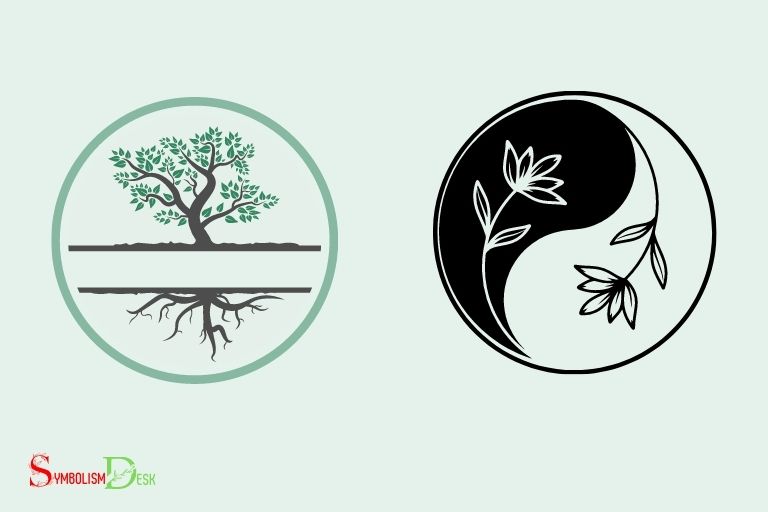What Does a Tree Symbol Mean? Stability!
A tree symbol represents growth, strength, stability, and connectedness to nature.
The tree symbol is found in various cultures and spiritual beliefs. It has always been a powerful emblem because of its deep-rooted connection to the earth and the natural world.
Due to its many branches, roots, and leaves, the tree is also seen as a symbol of life, family, and unity.
The tree symbol has been universally respected and revered across the globe for its symbolism and significance.
It conveys growth through the stages of life, strength in its unwavering stability, and connectedness to the very essence of nature.
By understanding and appreciating the tree symbol, we can embrace the valuable lessons it teaches us about life, unity, and spirituality.
Interpretations and Meanings of Tree Symbols
| Tree Symbol | Meaning |
|---|---|
| Growth | Trees are often used to symbolize personal or spiritual growth, as they start from a small seed and grow into tall, strong plants. |
| Strength | The strength and sturdiness of a tree’s trunk and branches can symbolize inner strength and resilience in the face of adversity. |
| Life Cycle | Trees represent the full cycle of life: from birth (sprouting) to growth (maturing) to death (shedding leaves and eventually falling). They also represent renewal through the annual cycle of seasons. |
| Connection | Trees are often seen as a symbol of connection, as their roots go deep into the ground and their branches reach high into the sky, connecting the earth and the heavens. |
| Knowledge | In many cultures, trees represent knowledge and wisdom, such as the Tree of Knowledge in the Bible or the tree of enlightenment in Buddhism. |
| Fertility | The abundance of leaves, flowers, and fruit on trees can symbolize fertility and abundance in a person’s life. |
| Stability | Trees are deeply rooted in the earth, providing a sense of stability and groundedness. This makes them an appropriate symbol for feelings of security and steadfastness. |
| Shelter | Trees provide shelter and protection for many living beings, so they can symbolize feelings of safety and nurturing. |
Key Takeaway

Five Intriguing Facts about Tree Symbols
Understanding The Significance Of A Tree Symbol
What does a tree symbol mean? Understanding the significance of a tree symbol
Trees have been used in various cultures throughout history as symbols of strength, growth, and endurance. We will examine the significance of a tree symbol in different cultures and religions.
Historical And Cultural Significance Of Tree Symbolism
Trees have played a vital role in many cultures and civilizations throughout history.
Some of the significant cultural and historical references to trees include:
- In ancient egypt, trees represented creation, life, and death. The sycamore tree was considered the tree of life, while the acacia tree symbolized resurrection.
- The ancient greeks believed that trees were sacred and associated them with their gods and goddesses. The olive tree was a symbol of peace and wisdom, representing the goddess athena.
- In celtic cultures, trees were associated with wisdom and were believed to have magical powers. The oak tree, in particular, was considered sacred, symbolizing strength, endurance, and protection.
- In native american cultures, trees were believed to connect the earth and sky and were seen as a symbol of balance and harmony. The cedar tree was considered a powerful symbol of healing, purification, and protection.
The Symbolic Role Of Trees In Ancient Cultures And Religions
Trees played a crucial role in many ancient religions, often representing growth and transcendence.
Some of the symbolic meanings of trees in ancient cultures and religions include:
- In christianity, the tree is used as a symbol of the cross on which jesus was crucified. The tree symbolizes the forgiveness of sins and the sacrifice of jesus.
- In hinduism, the banyan tree is seen as a symbol of eternal life. It is believed that the tree’s roots represent the divine and the branches represent the physical world.
- In buddhism, the bodhi tree is considered sacred and represents enlightenment. It is believed that the buddha attained enlightenment while sitting under the bodhi tree.
- In norse mythology, yggdrasil, the world tree, represented the bond between the gods, humans, and the underworld. The tree symbolized balance and harmony.
The Representation Of Trees In Mythologies And Stories
Trees also play a significant role in many mythologies and stories, representing various themes and concepts.
Some of the well-known representations of trees in mythologies and stories are:
- The tree of knowledge, which is mentioned in the bible’s book of genesis. It is believed that adam and eve ate from the tree of knowledge, which caused them to gain knowledge of good and evil.
- In norse mythology, the world tree yggdrasil was believed to be the source of all life.
- In greek mythology, the golden apple tree was a powerful symbol of beauty, youth, and vitality. It is famously associated with the story of paris, who was tasked with awarding the golden apple to the most beautiful goddess.
- In the story of the giving tree, written by shel silverstein, the tree symbolizes unconditional love and self-sacrifice.
Trees have been used throughout history as powerful symbols in various cultures, religions and mythologies, representing themes such as strength, growth, balance, and knowledge.
Understanding the significance of a tree symbol can help us appreciate their importance as cultural, spiritual, and natural figures.
Different Types Of Tree Symbols And Their Meanings
Trees have always been symbols of life and growth. Their enduring existence, deep roots, and the way they reach towards the sky has made them a constant presence in myths and legends.
People have used trees as symbols for centuries to convey ideas and beliefs, and every type of tree has its own unique symbolism.
Here are some of the meanings behind different types of tree symbols.
Oak Trees: Strength, Endurance, And Nobility
Oak trees are often associated with concepts like strength, endurance, and nobility. In ancient cultures, the oak tree was considered sacred and was often a symbol of the ruler’s power.
Here are some of the main points about oak tree symbols:
- They are known for their durability and strength, making them a symbol of endurance and perseverance.
- Many cultures consider the oak tree a symbol of nobility, as it was associated with powerful rulers and leaders.
- Oak trees are also associated with the autumn season, which represents the cycle of life and death.
Willow Trees: Flexibility, Intuition, And Gracefulness
Willow trees are often linked to characteristics like flexibility, intuition, and gracefulness. The willow is known for its long, thin branches that bend easily in the wind.
Here are some key points about willow tree symbols:
- The flexibility of the willow tree is often associated with the idea of going with the flow, adapting to change, and being able to bend without breaking.
- The willow tree’s association with the water, due to often growing near rivers and lakes, led it to be a symbol of intuition and sensitivity.
- Its gracefulness, reflecting the way its branches sway gently in the breeze, has led some to associate the tree with femininity.
Cherry Blossom Trees: Beauty, Transience, And Renewal
Cherry blossom trees are most often associated with beauty and transience. Their blooms are delicate and short-lived, adding to their symbolic value.
Here are some key points about cherry blossom tree symbols:
- Cherry blossom trees’ short-lived blooms represent the idea of transience and the fleetingness of beauty.
- But the blooms’ return each year led the cherry blossom tree to symbolize renewal and the arrival of spring.
- Additionally, in japanese culture, the cherry blossom tree represents the samurai’s warrior spirit, with the blossoms being seen as a metaphor for the shortness and fragility of life.
Pine Trees: Immortality, Longevity, And Stability
Pine trees are symbols of immortality, longevity, and stability. They have always been considered a symbol of resilience as they can grow in barren and rocky landscapes.
Here are some key points about the pine tree symbols:
- Pine trees are often used as symbols of immortality and longevity because they remain green all year round and are known for their longevity.
- They were also used by ancient mariners as a navigation tool because their branches always point towards the north, symbolizing stability and a firm direction.
- The pine tree’s association with winter and the tough growing conditions it endures also symbolizes resilience.
Apple Trees: Fertility, Prosperity, And Abundance
Apple trees are symbols of fertility, prosperity, and abundance. They are often associated with the harvest season, and their fruit has long been a symbol of life and vitality.
Here are some key points about the apple tree symbols:
- Apple trees are often associated with fertility because they produce a large number of fruit every year.
- The apple itself represents prosperity and abundance and is often used in myths and legends to symbolize life and vitality.
- Apple trees’ association with the harvest season, when the fruit is ripe and ready to be picked, symbolizes the idea of reaping what you sow and enjoying the fruits of your labor.
Overall, tree symbols have been used for centuries to convey ideas and beliefs. Every type of tree has its own unique symbolism, with distinct meanings that have stood the test of time.
Understanding these meanings can help us connect with nature and use the trees’ symbolism as inspiration in our daily lives.
The Importance Of Tree Symbols In Art And Design
Overview Of How Trees Are Used In Art And Design
Trees, as a natural element of our environment, have been used in art and design for centuries. They can often symbolize life, growth, stability, and tranquility.
Here are some of the ways trees are used in art and design:
- Trees are often used as stand-alone subjects in artwork, such as paintings and drawings, as they create a natural aesthetic and can provide depth and scale to a piece.
- They are also used in patterns and designs, as well as in architecture, such as wooden beams and pillars, further enhancing their significance in human-made art and design.
- Trees are also used to convey environmental messages and themes, such as conservation and sustainability, making them a powerful visual symbol.
An Exploration Of The Different Styles And Techniques Of Tree Symbol In Art And Design
Trees can be depicted in various styles and techniques in art and design, depending on the artist’s interpretation and the message a particular piece wishes to convey.
Some of the common styles and techniques include:
- Realistic interpretations of a tree, where artists use natural colors and textures to capture the true essence of a tree, making it look almost like a photograph.
- Surrealist approaches, where trees are used in avant-garde ways and can range from simple shapes to complex, abstract designs.
- Trees can also be stylized, where artists use geometric shapes and patterns to create a decorative effect.
The Impact Of Symbolic Trees In Various Forms Of Visual Media
Trees are a familiar and universal symbol that can be found in various forms of visual media such as advertising, logos, and product packaging.
They can influence a customer’s perception of a brand, product, or service by suggesting that the business is environmentally aware and conscious or perhaps environmentally sustainable.
Utilizing the symbolic importance of trees effectively can create long-lasting, positive impressions on audiences.
An Analysis Of Famous Examples Of Tree Symbolism In Art And Design
Tree symbolism is often seen in famous works in art and design.
Here are some famous examples, which have used tree symbolism:
- Vincent van gogh’s painting, “the mulberry tree” portrays the beauty of nature, as well as its destructibility, which can also represent the loss of innocence or tragedies that humans face in life.
- Gustav klimt’s iconic painting, “the tree of life” symbolizes growth, strength, and connection to both the earth and heavenly realms.
- The famous logo of the canadian company, roots, features a simple tree on a black background, representing the company’s commitment to nature, heritage, and environmental sustainability.
Trees have been and continue to be a source of inspiration for artists and designers alike.
They offer a wide range of possibilities in terms of interpretation, style, and technique, making them a versatile and rich source of symbolism for visual media.
Tree Symbolism In Literature And Poetry
The Intersection Of Trees And Literature And Poetry
Throughout history, trees have been a popular literary device. Authors and poets often invoke tree symbolism in their works to portray several meanings, including growth, stability, and resilience.
Trees not only serve as a natural object, but they also represent something deeper, making them a powerful symbol.
Examples Of Famous Literary And Poetic Works That Feature Trees As Symbols
Many writers have used trees as symbols in their works. Some of the famous literary works include “the giving tree” by shel silverstein, “the lord of the rings” by j. r. r. Tolkien, and “the scarlet letter” by nathaniel hawthorne.
In poetry, writers like emily dickinson, william wordsworth, and robert frost have also used trees as symbols in their works.
- “the giving tree” by shel silverstein: The story of a selfless apple tree that gives everything to a boy who grows up to be a man.
- “the lord of the rings” by j.r.r. Tolkien: The white tree of gondor represents the struggle against evil and is a symbol of hope.
- “the scarlet letter” by nathaniel hawthorne: The tree serves as a symbol of sin and shame, and it is where hester prynne’s daughter pearl often plays.
The Role Of Tree Symbols In Storytelling And Conveying A Message
Tree symbolism can help convey a message in a story or poem. Trees can be used to symbolize many things,
Such as:
- Life
- Growth
- Death
- Renewal
- Change
- Stability
- The passage of time
Tree symbolism allows writers to create a deeper meaning in their work and allows them to convey a message without being too explicit. It also helps readers understand the emotions and themes behind the story or poem better.
A Discussion On How Authors And Poets Use Trees For Metaphors And Allegories
Metaphors and allegories are used in poetry and literature to create a deeper meaning. Trees are often used as metaphors and allegories in literature and poetry.
For example:
- A tree could represent a person or a family’s stability over time.
- A tree could symbolize the natural cycle of life, death, and renewal.
- A tree could be a metaphor for growth and change.
Trees have been a powerful literary device in storytelling and poetry. They offer writers and poets a way to convey a message more profoundly and allow readers to understand the message better.
Trees are a symbol of life, growth, and hope, and they will continue to inspire writers and poets for generations to come.
The Modern Usage Of Tree Symbols
Trees have been used as symbols for centuries, and their meaning has evolved over time. Today, trees continue to hold significant symbolism, especially in modern-day branding, environmental activism, and various industries.
In this section of the blog post, we’ll explore the modern usage of tree symbols and how they are employed in marketing, nature advocacy, and other industries.
How Tree Symbols Are Used In Modern-Day Branding And Advertising
Trees and their imagery are often used in branding to evoke emotions, sentiments, and values.
Here are a few ways that tree symbols are utilized in branding and advertising:
- Companies use tree symbols to represent growth, stability, nature, and sustainability.
- Tree graphics are used to create a logo or emblem for businesses or products, particularly in the health and beauty industry.
- Airline companies use tree symbols in their branding to represent destinations and travel.
- Other industries, particularly those associated with nature, use tree symbols to create a connection with customers.
The Growing Popularity And Commercialization Of Tree Symbolism
With the rising interest in nature, tree symbolism is gaining popularity in commercial establishments.
Here are some ways that tree symbols are used commercially:
- A restaurant’s decor may include tree-themed sculptures, paintings, or even trees inside the establishment, to create a natural ambiance.
- Home decor companies incorporate tree imagery in various ways, such as tree-shaped bookshelves or tree-inspired wallpaper, to attract environmentally conscious consumers.
- Fashion houses use tree symbols in prints and embroidery on clothes, particularly in bohemian styles, to appeal to nature-lovers.
Environmental Activism And The Use Of Tree Symbols To Advocate For Nature Preservation
Tree symbols have played a significant role in environmental activism and advocacy.
Here are some ways that tree symbols are used for nature preservation:
- Environmental organizations use tree imagery to represent the importance of ecological balance and conservation.
- Advocates use tree graphics in posters and brochures to encourage people to join campaigns and raise awareness about environmental issues.
- Artists and designers use tree images to create eco-friendly merchandise to encourage consumers to switch to sustainable products.
How Tree Images Are Used In Different Industries, Including Fashion, Home Decor, And Technology.
Tree symbols are prominent in various industries, including fashion, home decor, and technology.
Here’s how tree images are used in these sectors:
- Fashion companies use tree symbols in different forms such as leaf patterns and tree-shaped jewelry, to entice environmentally conscious customers.
- The home decor industry includes images of trees in different products such as furniture, wallpaper, and wall art.
- Companies selling tech gadgets use tree imagery to portray their products as environmentally friendly and sustainable.
Tree symbols continue to hold significant meanings in modern-day society, including branding and marketing, environmental activism, and various industries.
Whether it’s a logo, a product design, or a campaign, tree symbolism holds immense potential for connecting with and influencing people’s emotions and values.
What Does the Army Symbol Represent in Terms of Strength?
The army symbol meaning and strength can often be described as a representation of courage, unity, and resilience. It serves as a powerful emblem that embodies the collective power and determination of the armed forces. Symbolizing the values of honor, loyalty, and sacrifice, the army symbol stands as a reminder of the unwavering strength possessed by those who serve and protect.
FAQ About What Does A Tree Symbol Mean
What Does A Tree Symbolize In Different Cultures?
Trees symbolize strength, resilience, growth, and wisdom in various cultures. For example, in celtic culture, trees represented harmony and balance.
What Is The Meaning Of A Tree Tattoo?
A tree tattoo can symbolize growth, transformation, and connection to nature. Different types of trees may represent different traits or meanings.
What Does It Mean To Dream Of A Tree?
Dreaming of a tree can symbolize stability, growth, and new beginnings. The type of tree and the condition of the tree in the dream can give further insights into its meaning.
What Is The Significance Of A Tree Of Life?
The tree of life is a symbol of regeneration, strength, and interconnectedness. It represents the cycle of life, death, and rebirth.
What Does A Tree Symbolize In Christianity?
In christianity, trees represent spiritual growth, eternal life, and connection to god. The idea of the tree of life is prominent in the bible and signifies nourishment and spiritual immortality.
Conclusion
As we explored the symbolism of trees, we found that they hold an important place in many cultures and traditions.
Trees are complex symbols that represent life, growth, strength, and endurance, while also acting as spiritual intermediaries. In many cultures, trees are seen as a connection between the earthly and spiritual realms, serving as a bridge for communicating with ancestors and spiritual guides. In Maori culture, the koru symbol interpretations of the unfurling fern frond represent new life, growth, and harmony with nature. The koru’s spiral shape is also associated with the concept of eternal renewal and the interconnectedness of all living things.
From the yggdrasil tree of norse mythology to the bodhi tree of buddhism, trees play a significant role in religion and mythology.
Moreover, trees hold practical value in our daily lives by providing us with clean air, shade, and resources. Whether it is a pine tree, a willow tree, or an apple tree, each tree type carries different connotations and meanings.
Understanding the symbolism of trees can be useful for many purposes, from artistic expression to spiritual practices.
So, next time you are surrounded by trees, take a moment to appreciate their significance and the meaning they hold.






